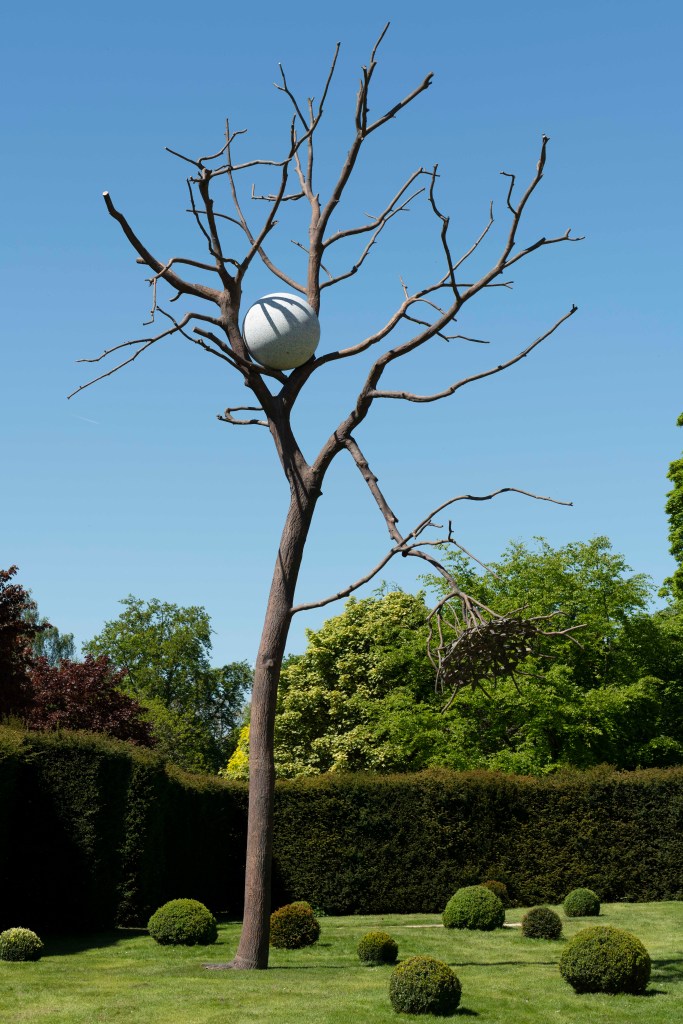About a dozen extra trees stand in Yorkshire Sculpture Park. Conspicuously tall and bald of leaves, their presence marks the arrival of Giuseppe Penone (b. 1947), a long-term admirer of this landscape.
Penone’s career began 50 years ago in the woods around Garessio, the village in Piedmont where he grew up. The young artist, who came to be associated with Arte Povera, made interventions in this growing environment. To make permanent his memory of grasping the trunk of a young tree, he attached a steel cast of his hand, impeding its growth at one spot. Half a century on, three casts of that tree, complete with this humanoid branch, stand at the entrance to YSP’s gallery space, charting six, eight and 12 years of growth.
Like Penone’s artworks, this collaboration has been long in the making. The artist first came to YSP in 1989, when it was just over a decade old. Since then it has grown to its current 500-acre sprawl, which makes it the largest sculpture park in Europe, and it has opened the Underground Gallery, which houses just over half of the works in this exhibition.

Matrix (2015), Giuseppe Penone. Photo: © Jonty Wilde; courtesy the artist and Yorkshire Sculpture Park
As is often the case in Penone’s indoor exhibitions, the centrepiece is a tall, or rather long, prone tree trunk. Matrix (2015) is bisected and hollowed out following the course of one growth ring. A bronze cast of the interior sits towards one end, a biomorphic form reminiscent of a surrealist object. Matrix runs through the three gallery spaces through a specially cut opening, a spine connecting Penone’s works across his career.
The undulating forms of Matrix are amplified by Propagation (1998/2018), a 16-metre-high wall drawing, a swirling pattern emanating from the whorls of the artist’s fingerprint. This analogy of skin and bark resonates throughout the exhibition. In one case, Skin of graphite – tondo I (2012), an enlarged drawing of an impression taken of the artist’s graphite-covered skin, a local genesis can be found. During his trip to Yorkshire in 1989, Penone visited a coal mine, experiencing a physical darkness that found form in slate drawings, and then in this series.

Light and Shade (2014), Giuseppe Penone. Photo: © Jonty Wilde; courtesy the artist and Yorkshire Sculpture Park
The novelty of this exhibition for British audiences is Penone’s work beyond the gallery’s glass walls. In the gardens outside, Penone has assembled eight bronze tree works, as if they are part of a single installation. The most unexpected feature of this display is the planting of topiary shrubs around Light and shadow (2004), which mimic the spherical boulder that sits high in its branches, and the form of the large tree which is part of the existing landscape.

Ideas of Stone – Elm (2008) Giuseppe Penone. Photo: © Jonty Wilde; courtesy the artist and Yorkshire Sculpture Park
Beyond these manicured lawns, one of Penone’s sculptures roams free in the wilderness towards the edges of the park. Ideas of Stone – Elm (2008) is nestled in a clearing under a canopy of trees. It could easily be missed by anyone who fails to raise their eyes to the canopy, to the river stone defying gravity among bronze branches. They cup the stone like a hand, bent at the wrist, arm rising from the ground. The anthropomorphism reminds us that, like this wilderness that was landscaped in the 18th century, Penone’s works are carefully cultivated.
At the apex of manufacture and nature, and at the peak of what was once Bretton Hall’s formal gardens, is Lightning-struck tree (2012). With its trunk split open and a sublime bolt of gold leaf marking and preserving the electrical impact, this tree stands like the artist, surveying the park.
‘Giuseppe Penone: A Tree in the Wood’ is at Yorkshire Sculpture Park until 28 April 2019.
Unlimited access from just $16 every 3 months
Subscribe to get unlimited and exclusive access to the top art stories, interviews and exhibition reviews.














![Masterpiece [Re]discovery 2022. Photo: Ben Fisher Photography, courtesy of Masterpiece London](http://www.apollo-magazine.com/wp-content/uploads/2022/07/MPL2022_4263.jpg)
What the dismantling of USAID means for world heritage